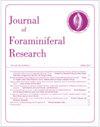微观到宏观尺度的有孔虫分布:Martin A.Buzas的贡献*
IF 0.7
4区 地球科学
Q4 PALEONTOLOGY
引用次数: 1
摘要
Martin A. Buzas在过去40多年里发表的研究对我们影响很大。这项研究有很多方面,无法在这篇简短的综述中处理。然而,微观到宏观尺度有孔虫分布的主题贯穿了布扎斯的研究生涯。发行版是Buzas非常喜欢的东西。他受过统计学和有孔虫方面的训练,所以他不可避免地要把他的统计分布知识和有孔虫在几个不同尺度上的分布结合起来。他在微观尺度上研究了有孔虫的分布,水平分布在10平方厘米的海底区域内,垂直分布在20厘米的岩心内。他还从事中尺度研究,通过开创性地使用一般线性模型,量化有孔虫分布与空间和时间环境变量的关系。这项研究提出了脉动斑块假说。他在宏观尺度上与S. J. Culver一起工作,定义了底栖有孔虫省的分布,表明所有有孔虫分布,特别是在北美和中美洲海岸周围,属于相同的统计分布。他们的工作记录了大西洋盆地深海底栖有孔虫多样性的群落组合和分解以及纬度模式。最近,布扎斯与数理统计学家哈耶克(L. C. Hayek)合作,深入研究了物种多样性的复杂性,并解决了一个50年来一直被认为难以解决的问题,即物种丰富度与物种均匀度之间的数学关系。这项工作引入了新的方法来理解社区结构和识别相邻社区之间的边界(SHE分析)。我们中的许多人在我们的职业生涯中工作很长时间,发表了很多论文,但我们中很少有人真正影响我们科学的基础。马蒂·布扎斯是一位微生物古生物学家,他的工作将具有持久的意义。本文章由计算机程序翻译,如有差异,请以英文原文为准。
Micro- to Macro-Scale Foraminiferal Distributions: The Contributions of Martin A. Buzas*
The research that Martin A. Buzas has published over the past more than 40 years has influenced us greatly. That research has many strands that cannot be dealt with in this short review. However, the theme of micro- to macroscale foraminiferal distributions is interwoven throughout Buzas's research career. Distributions are something that Buzas is very fond of. He was trained in statistics as well as foraminifera and so it was inevitable that he would combine his knowledge of statistical distributions with foraminiferal distributions at several different scales. He has studied the distribution of foraminifera at microscales, horizontally within a 10 cm2 area of the sea floor or vertically, cm by cm within a 20 cm core. He has also worked at the mesoscale, quantifying, through the pioneering use of the General Linear Model, the relationship of foraminiferal distributions and environmental variables in space and time. This research led to the hypothesis of pulsating patches. He has worked at the macroscale with S. J. Culver, defining the distribution of benthic foraminiferal provinces, showing that all foraminiferal distributions, particularly around the coasts of North and Central America, belong to the same statistical distribution. Their work has documented the assembly and disassembly of communities and the latitudinal patterns of deep-sea benthic foraminiferal diversity in the Atlantic basin. Most recently, with his coauthor, mathematical statistician L. C. Hayek, Buzas has delved deep into the intricacies of species diversity and solved a 50 year-old supposedly intractable problem of mathematically relating species richness with species evenness. This work led to the introduction of new approaches to understanding community structure and recognizing boundaries between adjacent communities (SHE analysis). Many of us work long hours and publish many papers over our careers but few of us truly influence the fundamentals of our science. Marty Buzas is one micropaleontologist whose work will be of lasting significance.
求助全文
通过发布文献求助,成功后即可免费获取论文全文。
去求助
来源期刊
CiteScore
2.10
自引率
9.10%
发文量
32
审稿时长
>12 weeks
期刊介绍:
JFR publishes original papers of international interest dealing with the Foraminifera and allied groups of organisms. Review articles are encouraged.

 求助内容:
求助内容: 应助结果提醒方式:
应助结果提醒方式:


